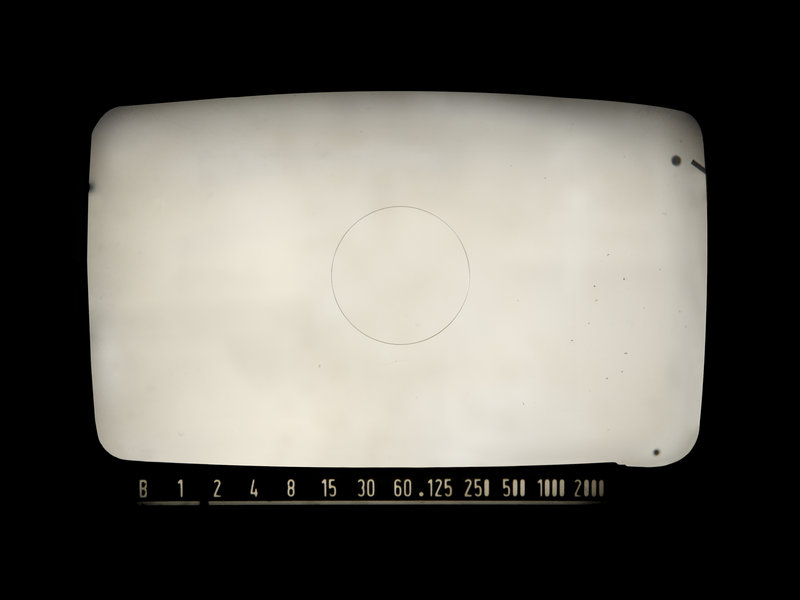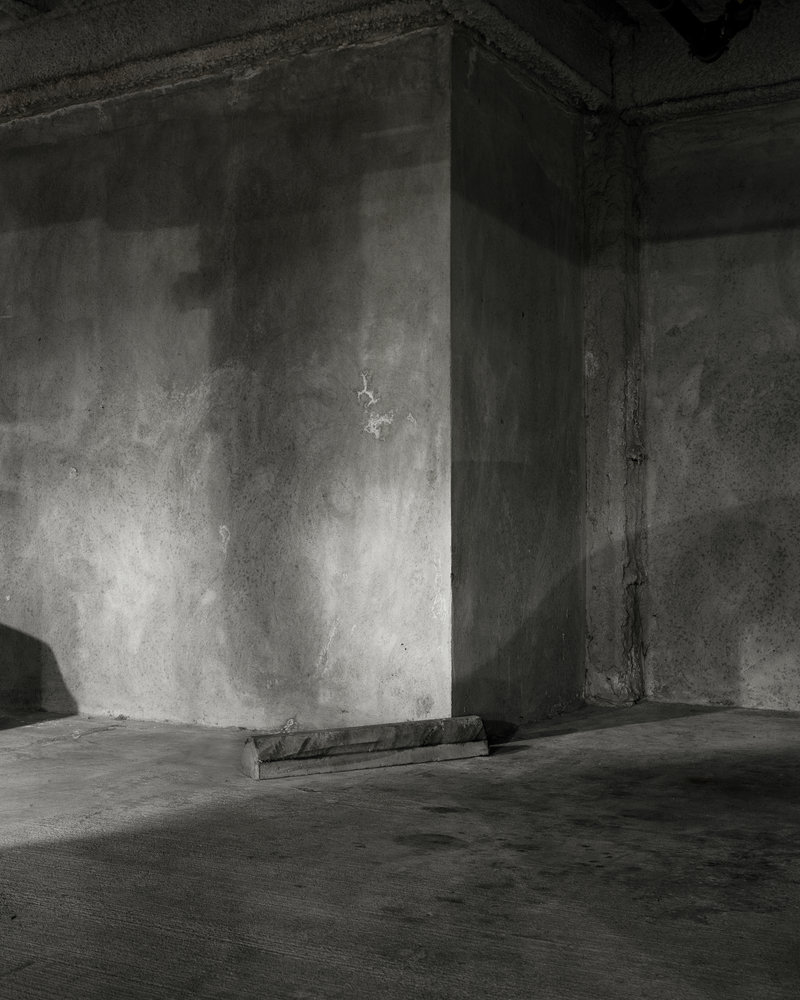“Blind Spots” at Space in Portland is a beautifully installed show in a spare and handsome space. It’s a white cube gallery show, but this one doesn’t just act the part — it actually lives up to the sophisticated expectations it sets before us.
Billie Mandle’s photographs are large and pristinely mounted images of parking garage interiors. Their high-focus finish revels in the stains on the cement walls and floor and their inherent painterly textures and fundamental spatial forms.
Meggan Gould’s works are images of camera viewfinders presented with the full frontal and scientific presentation of a microscopic slide. Gould also invests in face-mounting her images on Lucite, which further presses their status as glassy objects worthy of consideration. It’s a presentation to which I have always been partial; here, it’s not just elegant, but apt.
Mandle’s work immediately reminded me of Richard Diebenkorn’s geometrical but painterly “Ocean Park” series because of its rigorous but ultimately luscious compositional logic. Modern art usually plays up the tension between the spatial structure and the formal composition, so Mandle’s coaxing the surface and the rendered space into fully resolved concert with such whispered eloquence is an appreciable achievement.
In my first walk through the show, I was struck by many painterly references. Evoking Vermeer, Mandle’s “San Mateo 3” depicts a beam of light slicing down a wall from a high window. Gould’s presentation of the centering and framing devices of film camera viewfinders repeatedly touched on the centering and framing logic of the 1960s abstract painters such as Kenneth Noland and Jo Baer.
“San Mateo 15” features a wall covered in dripped stains compellingly redolent of Pat Steir’s paintings. But it also forces the question of black-and-white photography against the backdrop of painting.
Mandle’s works appear black and white, but a few trickles of brick red rust quietly infect the otherwise silent image with questions about technique and enhancement because the color feels like an afterthought — like a hand-colored photograph.
It turns out that Mandle actually removes signage and colored lines from her original photos. This is a common enough gesture in photography: Who hasn’t clicked the “red-eye removal” button to keep the dog from looking like a werewolf in a family photo?
But it’s worth clarifying here that image editing with Photoshop isn’t some basic push-button technique, but an art form with hugely varied degrees of success and skill. Mandle is ridiculously good at it.
However, when I think of a work such as Mandle’s “San Mateo 2” as a manipulated image, I don’t know if I particularly like the idea. The image is gorgeous. The composition and tonal balance are essentially perfect.
While this could not have been achieved without such invasive alteration, part of me doesn’t like the idea of so much technical backstory being necessary to understand what’s really going on. I know many folks demand effort and skill on the part of artists, and that artists want to be invested in their work, but I liked the work better when it was just a beautiful photograph. With so much intervention and the new digital printing processes, this isn’t even a photograph anymore; it’s a digital print. (To her credit, Mandle calls them “pigment prints.”)
Gould’s viewfinder images bring to mind Dozier Bell, one of Maine’s most talented and significant artists. Many of Bell’s paintings and drawings show realistically rendered clouds or seascapes with visual bits of targeting optics such as crosshairs.
They are brilliant works, but the martial nature of the targeting technology has a radical effect. Lofty clouds, for example, are no longer a spiritual haven but a terrifying realm of dogfights and death.
While Bell’s image mediation is geared towards tensions among vision, painting and people, Gould’s is somewhere between human optics and the culture of photography (you have to know the codes pictured to understand them — and our culture is in the process of losing our camera culture literacy).
Gould might strike some as a fanatical collector (some might see Mandle this way too, at a glance), but her collected work conveys not just technical information but cultural understanding. The viewfinders are not just found objects but the products of human design. And they reflect the reality that human vision is fundamentally mediated by our bodies — not just our eyes and brains, but our bilateral symmetry and vertical orientation in the landscape.
I particularly liked the ironic wit of one of Gould’s images in which the glass viewfinder was broken, throwing off the “objectivity” of its red grid. I was intrigued by the impenetrably icy depths of her “Viewfinder 4” — the glass was somehow lost beneath the very scratches that defined its physical presence.
But I am most fascinated with “Viewfinder 6.” It forces the issues of symmetry (by its uncanny asymmetry) and systems with its bits of metering codes that float between the arbitrariness of language and the geometrical mathematics of nature. Without giving anything away, “Viewfinder 6” lays plain Gould’s focus on visual conventions.
There have been many strong photography shows in Maine recently, and “Blind Spots” is definitely a high point. It is a brilliant and beautiful show.
Daniel Kany is an art historian who lives in Cumberland. He can be contacted at:
dankany@gmail.com
Send questions/comments to the editors.




Success. Please wait for the page to reload. If the page does not reload within 5 seconds, please refresh the page.
Enter your email and password to access comments.
Hi, to comment on stories you must . This profile is in addition to your subscription and website login.
Already have a commenting profile? .
Invalid username/password.
Please check your email to confirm and complete your registration.
Only subscribers are eligible to post comments. Please subscribe or login first for digital access. Here’s why.
Use the form below to reset your password. When you've submitted your account email, we will send an email with a reset code.